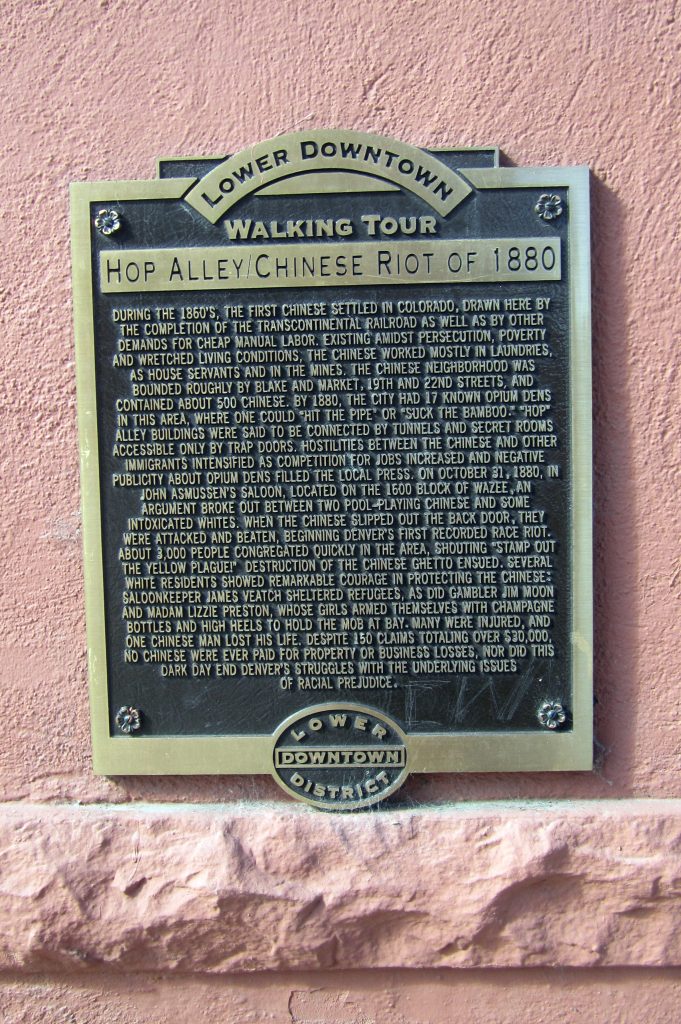Denver’s Only Chinatown Was Destroyed By Racists 139 Years Ago
On October 31, 1880, Denver saw its first race riot in the city’s history.
One hundred thirty-nine years ago, on this day, an argument broke out at John Asmussen’s Saloon on Wazee Street between two Chinese patrons playing pool and some intoxicated White patrons. In the 19th century, this area of downtown Denver was known as Hop Alley — the city’s Chinatown, with around 500 Chinese residents.
On the day of the Chinese Riot of 1880, the Chinese patrons slipped out of the back door after being harassed, when they were brutally attacked and beaten. Soon, a crowd composed of mostly Irish laborers gathered at the scene, and this group quickly turned into a mob of around 3,000 people shouting “stamp out the yellow plague!” and destroying Chinatown.
Many were injured and one man, a laundry worker named Sing Lee, was beaten to death after being dragged down the street with a rope around his neck. The anti-Chinese sentiments boiled over as rioters assaulted the Chinese men, throwing belongings out of windows and using wooden beams to destroy the frame buildings.
Although an estimated 150 claims were filed, totaling over $30,000 in damages, none of the Chinese residents were ever paid for their property or business losses.

Today, there is a plaque in lower downtown Denver remembering the riot. It reads:
“Several white residents showed remarkable courage in protecting the Chinese: Saloonkeeper James Veatch sheltered refugees, as did gambler Jim Moon and Madam Lizzie Preston… Many were injured, and one Chinese man lost his life.”
Colorado’s new state historian William Wei talked to the Colorado Public Radio, reflecting on this description of the riots.
“If you read this plaque carefully, you notice that it does not actually dwell on the victims of this race riot, the Chinese,” Wei said.
“Instead, it focuses on the heroes who came to their rescue. Let me say that I applaud the heroes who came to their aid, but it does reflect a certain attitude that persists today. The need… to have a white savior.”
Far too often, historical events involving ethnic minorities are told through the lens of White historians. Wei noted that the description of the riots was no exception.
“They’re not apt to identify the victims because that would humanize the experience, which I think they should do,” he said.
As it is described on the plaque, this brutal attack was far from the first or last act of violence and struggle the Denver Chinese community would face. After the Western portion of the transcontinental railroad was completed, Chinese workers were immediately laid off and eventually forced to turn to the mining industry for work.

Residents in Chinatown were also plagued with accusations of selling opium, which is where the name “Hop Alley” originates. There were indeed 17 opium dens in the city at this time, with 12 being located in Chinatown but it was not the Chinese residents who were responsible for fueling the opium businesses.
“The major customers were Denverites, white folks,” Wei told CPR. “They would come down to Chinatown and to participate in what today we would call drug abuse.”
“This was one of the few ways they could make a living,” he added.
The 1880 riot in Denver was just one of 153 anti-Chinese riots that took place in the American West during the 1870s and 1880s. Anti-Chinese sentiments were spread widely in the press, which referred to Chinese immigrants as the “pest of the Pacific.” With some White residents forming a movement, even marching through the streets carrying anti-Chinese banners and campaigning in support of a Chinese immigration ban.
After that violent night in 1880, Denver’s rioters escaped punishment. Those who were arrested were released due to supposed lack of evidence and Sing Lee’s murderers were acquitted in February 1881. The residents of Chinatown rebuilt their homes and businesses and by 1890, there were more than 980 Chinese immigrants living in Denver. However, this community in Chinatown was once again razed in 1940 for urban renewal.
Featured Image via Museum of Chinese in America / Public Domain
The post Denver’s Only Chinatown Was Destroyed By Racists 139 Years Ago appeared first on NextShark.
✍ Credit given to the original owner of this post : ☕ NextShark
🌐 Hit This Link To Find Out More On Their Articles...🏄🏻♀️ Enjoy Surfing!



















Post a Comment